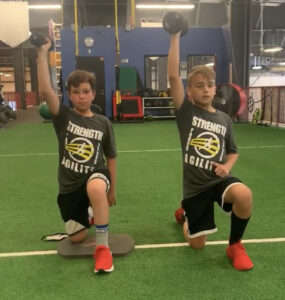The Importance of In-Season Training
With school back in session, student-athletes are finding themselves with busy schedules throughout the week with school, homework, extracurricular activities, and of course their fall sport. It can certainly be a challenge to find any extra time to dedicate for strength training.
During the busy summer training season this past summer at Elite, we worked with a wide variety of athletes training in preparation for their upcoming fall sport seasons. Many athletes tend to fall into a pattern of training consistently all summer and create a great foundational base of strength, power, and speed during their off-season. However, once September rolls around, many athletes have additional responsibilities and obligations they must attend to, including school work, athletics, and part-time employment. One activity that often gets put on the back burner is their strength and conditioning program. As a result, after just a short 2 weeks off from training, athletes begin to lose the strength and power base that they worked so hard for in their off-season. 
During the off-season training program, the athlete’s body experiences physiological changes that benefit them greatly when they return to competing during their season. These changes include improved neuromuscular function, improved oxygen levels throughout the body, and improved body composition. All of these changes to the athlete greatly benefit the athlete’s ability to perform their sport at the highest level. Continuing to train during the season will allow athletes to continue to improve in these areas as well as reduce the risk of injury during their practices and games.
A great analogy for athletes and parents to think regarding the benefits of in-season training is the following: “Off-season and In-season training are akin to opening an ‘athletic bank account.’ The off-season is where athletes make the most ‘deposits’ in the form of strength training, conditioning, and physical preparation work. Competition is where athletes make the most ‘withdrawals.’ In-season training allows athletes to keep their bank accounts top-upped so that they don’t ‘run out of money’. When they become overdrawn it results in fatigue and potential injury.” (Velocity Sports Performance).
During the athlete’s competition season, for team sports especially, the focus of training shifts to strength and power maintenance. The training program changes slightly from the off-season program but still maintains high intensity and moderate volume to ensure the athlete is reaping all of the benefits of strength training in-season. The best part is, athletes can benefit from training as little as 1 day per week if they have adequately prepared with an off-season training program! 
Elite Sports Performance & Physical Therapy offers Sports Performance and Athlete Training programs at both our Foxboro and Stoughton locations. We offer in-season training programs under the guidance and supervision of nationally-certified Strength and Conditioning Coaches at both locations! Contact Elite today to sign up and elevate your performance on the field or court this fall! To learn more about our programs for athletes of all ages and sports, click HERE or email us at EliteSPC@EliteFitCenter.com!
*Velocity Sports Performance. “The Importance of in-Season Training: Part 3.” Velocity Sports Performance, 2 Sept. 2019, velocityspusa.com/the-importance-of-in-season-training-part-3/.
